Your sanitizer solution is critical to ensuring food safety and preventing food-borne illness. This week, we’ll discuss how ServSafe Managers can ensure they mix and use sanitizer solutions properly for maximum effectiveness.

ServSafe MN Guide to Sanitizer Solutions
The following are the three sanitizer solutions the Minnesota Food Code approves for food preparation outlets.
- Bleach or Chlorine solution at 50 ppm for 10 seconds
- Iodine solution at 12.4 – 25 ppm for 30 seconds
- Quaternary ammonia solution at 200 – 400 ppm for 30 seconds
There are advantages and disadvantages to each of these three solutions. Bleach and quaternary ammonia solutions are currently the two most popular choices. Bleach is generally more affordable. However, it is easy to over-mix, creating the potential to remain on the surface of your utensils and surfaces. The chlorine residue will create a chemical contamination hazard. Quaternary ammonia solutions are more costly, but their safe concentration range is much broader. In addition, they are not as harsh on employee’s skin as chlorine solutions. Suppose you have questions about which solution is best for your facility. In that case, your local health department will usually be more than happy to recommend one and explain each product’s advantages.
Properly Mixing Your Solution
Unquestionably, the most accurate way to mix your solution is to have a service install a pump at a water source. These pumps will mix the solution into the water for you, creating a proper concentration. Many companies provide this service, and your health department should be able to direct you to one certified in your jurisdiction.
If you mix your sanitizer solutions manually, we strongly recommend using the proper test strip each time. A paper test strip will ensure you have not over- or under-mixed your chemical solution.
When using sanitizers, it is essential to change the solution often during heavy use to ensure it is still potent, store it below food preparation areas, and air-dry your surfaces before continuing work.
Finally, you should train your entire staff on properly sanitizing their workstations and regularly test your solutions to ensure you mix your chemicals safely. Proper use of sanitizers is a crucial element in serving and preparing safe-to-eat foods and is well worth reviewing even after you have gained your food manager certification in MN.
What is your perspective? How do you ensure proper workstation sanitation at your workplace?

